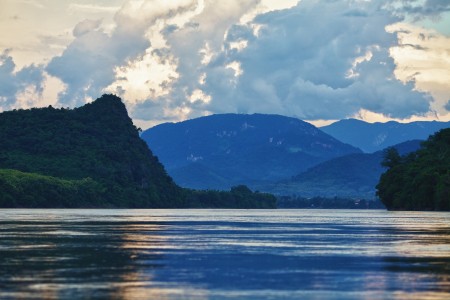This post is part of an online discussion on large-scale land interventions that runs through December 14, 2014. Can these initiatives fulfil their promises? Read more here and comment below or send an 800 word response to a.waldorf@cgiar.org.
Landscapes are receiving a lot of attention. There appears to exist a broad consensus that it is a good idea to work across sectorial boundaries and find combined solutions in landscapes…With some urgency, we need to demonstrate how the landscape approach can make a difference, and how it can be scaled up to meet our expectations – Peter Holmgren, CIFOR Director General
 Photo: Rob Schleiffert on Flickr
Photo: Rob Schleiffert on FlickrIn my practical experience I have come across various views that seem to suggest that ‘‘there is nothing we are trying to do now that has never been tried before.” This has often led me to reflect on why we have not made significant progress or impact despite all these good intentioned efforts. Consequently, I always have many more questions than answers but the questions may hint on of some of the answers. For instance:
- Why do we still have increasing problems of land degradation and food insecurity? Where have we been excelling or failing?
- What policy and institutional arrangements do we need to drive this agenda effectively?
- What mechanisms do we have for up-scaling or out-scaling the best practices that we have developed and pilot-tested so far?
- What monitoring, reporting and verification systems do we have to justify and demonstrate progress and global benefits? Are we at par with expectations and needs of our intended beneficiaries?
- Do we have sufficient mechanisms for knowledge generation, storage, tracking and retrieval for use and future reference?
In this blog I intend to share practical examples of national level landscape initiatives in Malawi from which we can draw useful lessons for the ‘Landscapes Approach’. The programs involved are designed and implemented in the Shire River Basin (SRB) by different government agencies, NGOs, development partners and communities.
The SRB is currently a hub for various ecosystem goods and services including electricity generation, supply of drinking water to Blantyre City, supply of green water for irrigation and sustenance of catchment functions for wildlife parks and reserves. However, overtime, the provision of goods and services has been threatened by increasing rates of deforestation, soil erosion, siltation of water bodies and land degradation; prompting government and other stakeholders to pursue a basin-wide approach to planning, development and management.
Projects in the Shire River Basin include Sustainable Land Management, Climate Adaptation for Rural Livelihoods and Agriculture, Shire River Basin Management, Integrated Ecosystem Based Management, Total Land Care.
Overall, the projects cited are implementing both upstream and downstream activities to develop and promote resilient community livelihoods ranging from entrepreneurial skills development for income generating activities, afforestation/reforestation, agroforestry, climate smart agriculture, small-scale irrigation, water conservation, livestock development, energy development and supply, and rehabilitation and restoration of streams and rivers in the Shire River Basin.
Challenges and Constraints
In implementing these initiatives several constraints have been experienced.
There has been a general lack of understanding and respect for land and environmental ethics: these are often violated by some development approaches that lack innovation and are often approached with the business as usual attitude.
There has also been a lack of significant investments in land and environment development. With hardly any investment in land conservation unless it is coupled with commercial development benefits or returns, the perception is that investments in environment and natural resources management are too risky.
Where SLM practices have been adopted, piecemeal, fragmented or conflicting approaches in planning and programming often hamper attainment of intended ecosystem goals. At the end, most people, including experts, are stuck in their silos with fixed mind-sets that force them to pursue sectoral-based initiatives with an illusion of attaining landscape level goals.
Turning to Opportunities
In fostering the landscape approach we need to reflect and undertake various approaches:
- Create a foundation: start by mapping existing landscape initiatives and approaches and identify lead agencies and champions for such initiatives.
- Analyze and identify what works and what has not worked in past efforts in order to fill gaps, capacity building and up-scaling of best tested practices.
- Undertake policy and institutional reforms for a transformative change; accompanied by development of robust investment plans for the landscape initiatives.
- Create a strong platform for networking and sharing of key landscape initiatives, lessons learned, challenges and successes of the programs.
My answer is ‘yes’
On whether large-scale land initiatives can fulfil their promise, my short answer is ‘Yes’ but they require adjustments and transformative reforms of old ideas and approaches on sustainable land management.
Successful investments from governments, the private sector and farmers require incentives and institutional arrangements. I suggest we:
- Create policies that recognize households as well community-based enterprises for livelihood development – these garner ownership at various levels and can be sustained over time at various landscape levels. However, such enabling policies are hardly existent in many areas.
- Create leadership, governance structures, and build capacities at community, landscape and national levels, such as the existence of basin authorities that have power for planning, regulatory functions and channeling of profits to local development.
In the SRB, plans are underway to establish a basin authority and a trust to provide oversight functions in planning, law enforcement and promotion of sustainable development in the context of a Payment for Ecosystem Services scheme.
So far, the approach has potential to attract and engage stakeholders at various levels of the Shire River Basin. I am looking forward to the Global Landscapes Forum in Lima to learn and share experiences with other countries.
Aloysius Kamperewera is a panelist at the Global Landscapes Forum session: Large Scale Land Restoration – Creating the Conditions for Success on December 7th.


















Add new comment